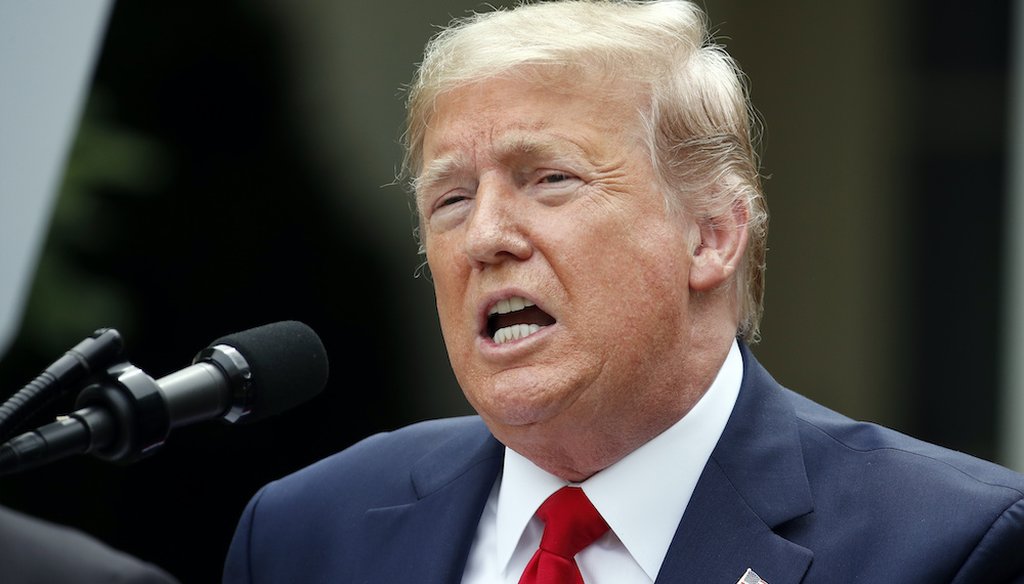Get PolitiFact in your inbox.

President Donald Trump speaks in the Rose Garden of the White House. (AP Photo/Alex Brandon)
If Your Time is short
-
Donald Trump used China’s role in the coronavirus crisis to justify withdrawing from the World Health Organization.
-
He falsely accused WHO of ignoring research articles when the articles did not exist.
-
He ignored actions WHO took to alert the global public health community.
-
He assumed that WHO knew that China was censoring reports of the spread of the disease. There is no evidence to support that WHO knew of a cover-up.
President Donald Trump linked his decision to withdraw the United States from the World Health Organization to China and the coronavirus crisis.
"China’s cover-up of the Wuhan virus allowed the disease to spread all over the world," Trump said May 29. "Chinese officials ignored their reporting obligations to the World Health Organization and pressured the World Health Organization to mislead the world when the virus was first discovered by Chinese authorities."
Trump’s allegations mirror his list of complaints in a May 18 letter that he was giving the organization a month to initiate reforms or permanently lose American support and membership. The U.S. paid over $400 million to the organization in 2019.
China has become a key target as Trump readies for the 2020 election and its role as the birthplace of the virus is central to Trump’s overarching message. But Trump’s case against China, as outlined in the WHO letter and elsewhere, had several factual errors and omitted key details.
The World Health Organization consistently ignored credible reports of the virus spreading in Wuhan in early December 2019 or even earlier, including reports from the Lancet medical journal. The World Health Organization failed to independently investigate credible reports that conflicted directly with the Chinese government's official accounts, even those that came from sources within Wuhan itself.
The Lancet said in a letter posted on Twitter, "this statement is factually incorrect."
"The Lancet published no report in December 2019 referring to a virus or outbreak in Wuhan or anywhere else in China." the journal said.
Its first articles came on Jan. 24, 2020. One described the first 41 patients with COVID-19 documented by Chinese doctors and researchers. The other described the first hard evidence of person-to-person transmission.
For its part, WHO director Tedros Adhanom Ghebreyesus said WHO first picked up signs of an emerging infectious disease Dec. 31 through its epidemic monitoring system and the next day asked China for more details. It also activated a unit called the Incident Management Support Team to coordinate WHO’s response.
The Trump administration’s own letter cast doubt on the charge that WHO knew something in early December. After leveling the accusation, it said, "By no later than Dec. 30, 2019, the World Health Organization office in Beijing knew that there was a ‘major public health’ concern in Wuhan." That broadly aligns with what Tedros said, allowing that the scale of the outbreak was still unknown.
By the next day, (Dec. 31) Taiwanese authorities had communicated information to the World Health Organization indicating human-to-human transmission of a new virus. Yet the World Health Organization chose not to share any of this critical information with the rest of the world, probably for political reasons.
This exaggerates both what Taiwan said in an email to WHO and what WHO did as it learned more about the outbreak.
Taiwan’s Dec. 31 email to WHO said news reports in China "indicate that at least seven atypical pneumonia cases were reported in Wuhan." The email went on to say that Chinese health officials said "the cases were believed not SARS, however, the samples are still under examination, and cases have been isolated for treatment."
Taiwan asked for more information. There was nothing specific about person-to-person transmission, but the comparison to SARS, an infectious disease, and the isolation of patients showed that infectiousness was seen as a possibility.
WHO said that after formally asking China on Jan. 1 to verify the cluster of cases, it tweeted about the incident on Jan. 4 and provided more details on its emergency information site Jan. 5, a site used by all WHO members.
The International Health Regulations require countries to report the risk of a health emergency within 24 hours. But China did not inform the World Health Organization of Wuhan's several cases of pneumonia, of unknown origin, until Dec. 31, 2019, even though it likely had knowledge of these cases days or weeks earlier.
This could be partially accurate, but it pushes the limits of what is actually known.
A doctor in Wuhan warned his colleagues in a chat group about a disease that looked like SARS on Dec. 30. Local officials muzzled the doctor, who later died from COVID-19.
"We now have good evidence that Chinese authorities knew about the spread and were hiding it at this time," Ashish K. Jha, director of Harvard’s Global Health Institute told us in April. "Whistleblowers and ‘rumor mongers’ among healthcare professionals were silenced. But it’s unclear how much the WHO could have possibly known about that at the time."
All the same, China reported the disease cluster by Dec. 31. It is also unclear how well doctors in Wuhan were connecting the dots.
The Chinese government stifled legitimate questioning, but it’s also possible that the progression period for the illness itself made it harder for health professionals to spot patterns. Chinese epidemiologists and physicians wrote in the New England Journal of Medicine that they estimated the first case occurred Dec. 10, but nearly 90% of the cases were not hospitalized until five days after the first sign of illness. That could have delayed how quickly the disease raised red flags.
The bottom line is that the gap is still unknown.
On Jan. 14, 2020, the World Health Organization gratuitously reaffirmed China's now-debunked claim that the coronavirus could not be transmitted between humans, stating: "Preliminary investigations conducted by the Chinese authorities have found no clear evidence of human-to-human transmission of the novel coronavirus (2019-nCov) identified in Wuhan, China." This assertion was in direct conflict with censored reports from Wuhan.
This blends an accurate statement with the assumption that WHO knew that China was hiding key data.
On Jan. 12, WHO said that "there is no clear evidence that the virus passes easily from person to person."
On Jan. 14, WHO’s lead investigator Maria Van Kerkhove told reporters that "it is possible that there is limited human-to-human transmission, potentially among families, but it is very clear right now that we have no sustained human-to-human transmission."
Van Kerkhove, however, warned that a wider outbreak was possible and that WHO had told hospitals around the world to take steps to prevent spreading the infection.
The missing piece here is that Trump’s letter assumes that WHO knew more about the situation on the ground than China was letting on, but he provides no evidence for that.
On Jan. 28, 2020, after meeting with President Xi in Beijing, you praised the Chinese government for its "transparency" with respect to the coronavirus, announcing that China had set a "new standard for outbreak control" and "bought the world time." You did not mention that China had, by then, silenced or punished several doctors for speaking out about the virus and restricted Chinese institutions from publishing information about it.
The quotes from Tedros are accurate. He said those things after his meeting with Xi.
What Trump leaves out is that he also praised Xi at that time.
"China has been working very hard to contain the Coronavirus, Trump tweeted Jan. 24. "The United States greatly appreciates their efforts and transparency. It will all work out well."
Our Sources
White House, Remarks by President Trump on Actions Against China, May 29, 2020
White House, Letter to World Health Organization, May 18, 2020
The Lancet, tweet, May 19, 2020
World Health Organization, WHO Director-General's opening remarks at the media briefing on COVID-19, April 29, 2020
Taiwan Centers for Disease Control, Dec. 31 email to WHO, April 11, 2020
New England Journal of Medicine, Early Transmission Dynamics in Wuhan, China, of Novel Coronavirus–Infected Pneumonia, March 26, 2020
World Health Organization, COVID-19 virtual press conference, April 20, 2020
World Health Organization, Statement on the second meeting of the International Health Regulations (2005) Emergency Committee regarding the outbreak of novel coronavirus (2019-nCoV), Jan. 30, 2020
World Health Organization, Statement on the meeting of the International Health Regulations (2005) Emergency Committee regarding the outbreak of novel coronavirus (2019-nCoV), Jan. 23, 2020
World Health Organization, WHO advice for international travel and trade in relation to the outbreak of pneumonia caused by a new coronavirus in China, Jan. 10, 2020
Xinhua, Experts say preliminary progress has been made in the etiology identification of the unexplained viral pneumonia epidemic of the new coronavirus Wuhan, Jan. 9, 2020
Reuters, WHO says new China coronavirus could spread, warns hospitals worldwide, Jan. 14, 2020
Kaiser Family Foundation, The U.S. Government and the World Health Organization, April 16, 2020
Washington Post, Fact-checking Trump’s letter blasting the World Health Organization, May 20, 2020
NPR, Fact-Checking And Assessing Trump's Letter Of Rebuke To WHO, May 20, 2020
Email exchange, Ashish K. Jha, director, Harvard Global Health Institute, April 16, 2020




















































